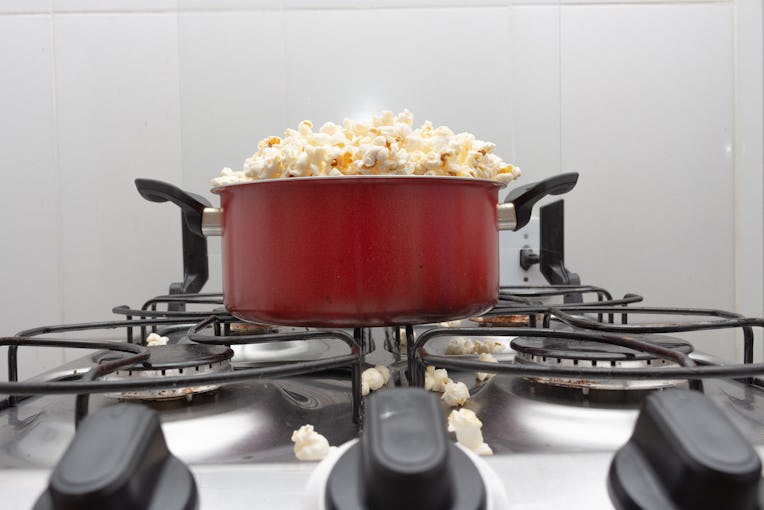You can tell a lot about someone by how they take their popcorn. From air-popped and nooch-dusted to drenched in hot grease, the snack can be as virtuous or hedonistic as you want. But the real question is: are you a popcorn consumer or a popcorn creator?
Making popcorn is up there with eggs, noodles, and rice as something everyone should learn to perfect whether or not they are broke. By “making popcorn,” I don’t mean placing an unwrapped pouch in the microwave and pressing a button. Microwave popcorn is a great option unless you are concerned about single use plastics, PFCs, and/or hydrogenated trans fats... but at least they stopped using diacetyl.
The next level of popcorn commitment is a dedicated device, like an air popper or one of these silicone bowls, but these pose the opposite problem of microwave maximalism: austerity. Even a mouthful of air-popped popcorn tastes like deprivation. I would rather have a boiled egg.
My coworker Darcie loves her Whirley Pop, a stovetop popper with a crank that keeps the popcorn from burning. I love that for her, but I still only recommend you use a large pot. With that, a fresh bag of grains, and the following techniques, you can quickly make the perfect snack.
Texture
People tend to focus on how to flavor popcorn, but your first concern should be texture. Fresh popcorn is a cheap but crucial investment. Beneath the tough exterior and starchy endosperm of each kernel is a tiny drop of water that converts into the steam that makes popcorn pop. But it can dry out, which leads to less-explosive popping and dense, tough popcorn. Do not buy popcorn in bulk or prepare to be disappointed. It doesn’t take long for an opened bag of popcorn to lose its lift, especially if it's humid out.
You want to drop the kernels in a hot pan so they erupt as quickly as possible. Heat your pan on high until it is hot before adding your oil and let that heat up before you drop the kernels. You can drop a test kernel and wait until it pops so you know the oil is hot enough.
Once popped, the kernels continue to release steam which is then reabsorbed by the popcorn, so you need a release for that moisture. A tip I learned from a former chef for dry, crispy popcorn is something you probably already have in your kitchen — a metal sieve which, when inverted, becomes a vented domed lid, just right for letting steam out and keeping popcorn in.
“Butter”
There is a whole industry devoted to making popcorn taste like a movie theater smells, but according to a lot of people who used to work in movie theaters, the secret is Flavacol, a butter flavored salt with “just the right blend of Yellow #5 and #6.”
It makes sense why movie theaters stick with chemical formulas for their butter topping, but simple melted butter is not the best choice for your popcorn either. Real butter is composed of 20 percent water and can end up making your crunchy popcorn soggy. Clarified butter or ghee, on the other hand, are great choices, and my current favorite is butter-flavored coconut oil which hits those nostalgic fake butter notes.
You also don’t want to cook popcorn in butter because the milk solids will burn. Movie theaters use coconut and peanut oils for popping which can be used at high temperatures and have an unctuous, almost buttery texture.
Dusts
Finely pulverized salt can be made in a blender and will cover every popcorn kernel like a halo, but I know most people aren’t going to take it that far. I’m usually an oil and salt purist, but I do think popcorn is the one appropriate use for truffle salt. Really, any fine dust will stick if you sprinkle it immediately after your popcorn is done. Nutritional yeast is popular as a buttery-cheesy shake, but it is not for me. Consider ranch seasoning, furikake, crushed freeze-dried raspberries, a ramen packet, or dehydrated vinegar.
Popcorn for any pot
- Popcorn
- Peanut oil, coconut oil, or olive oil
- Salt
- A pot
- A metal sieve as wide as the pot or a splatter screen
- Heat your pot on high until it is very hot, then add enough oil to cover the entire bottom surface.
- Drop a single popcorn kernel into the pot while the oil heats. Once it pops, you know your oil is hot enough and you can add enough popcorn to coat the bottom of the pan and sprinkle with fine salt.
- Cook on high heat, shaking the pot for a couple minutes until the kernels start to pop. Cover with an inverted sieve, or a splatter screen and reduce the heat to medium as the popcorn starts to mount. When the pops slow to one or two every second, turn off the heat and let the popcorn sit for another ten seconds to finish cooking and dry out a bit.
- Dump into a bowl and sprinkle with more salt if necessary or other stuff as desired.
